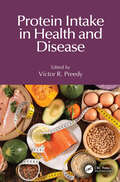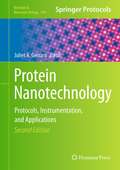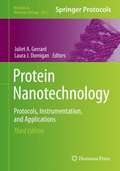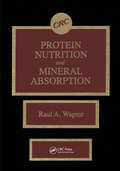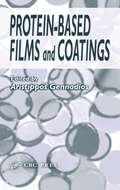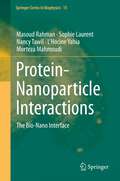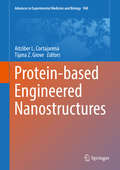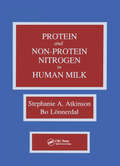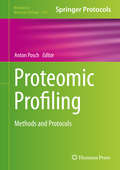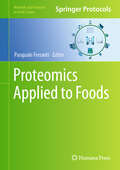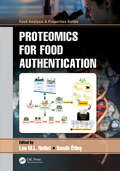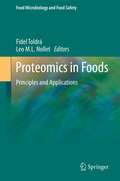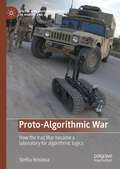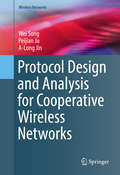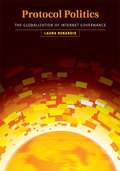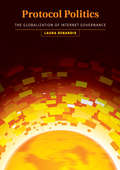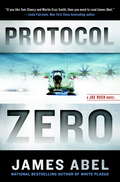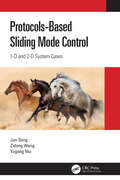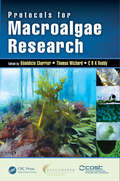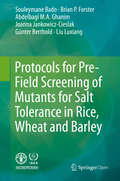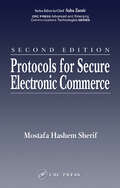- Table View
- List View
Protein Foods Are Good for You! (Healthy Foods)
by Gloria KosterAlmonds, eggs, and beans . . . What do these protein foods have in common? They’re all healthy! Discover where protein foods come from, what nutrition they provide, and how they help form a healthy diet. Filled with meaty facts, including meat alternatives, this Pebble Explore book will give curious young readers—and report writers—plenty to chew on.
Protein Foods Are Good for You! (Healthy Foods)
by Gloria KosterAlmonds, eggs, and beans . . . What do these protein foods have in common? They’re all healthy! Discover where protein foods come from, what nutrition they provide, and how they help form a healthy diet. Filled with meaty facts, including meat alternatives, this Pebble Explore book will give curious young readers—and report writers—plenty to chew on.
Protein Intake in Health and Disease
by Victor R. PreedyProteins are fundamental to human health, serving as building blocks for cellular structures, providing essential energy, and supporting tissue function. In Protein Intake in Health and Disease, the critical biomedical and nutritional roles of protein in the diet are explored in depth. Topics include protein quality, the impact of both low and high-protein diets, and the metabolic disorders and diseases linked to protein malnutrition. The book delves into protein’s influence across the lifespan, from maternal health and early development to the nutritional needs of children, adolescents, and the aging population. Each chapter is enriched with practical insights for broader health applications and concise summary points to aid understanding.Features Contains a mini dictionary of terms and summary points in each chapter to facilitate clear understanding Highly illustrated with figures and multiple tables in each chapter Chapter contributors represent global coverage This book is written for nutritionists, food scientists, and health care professionals, as well as research scientists and practitioners. It is also practically designed for policy makers and libraries.
Protein Nanotechnology
by Juliet A. GerrardSince the first edition of Protein Nanotechnology Protocols Instruments and Applications the intersection of protein science and nanotechnology has become an exciting frontier in interdisciplinary sciences. The second edition of Protein Nanotechnology Protocols Instruments and Applications expands upon the previous editions with current, detailed chapters that provide examples of proteins which are now being harnessed for a wide range of applications, some more developed than others. This book also delves into engineering proteins and an overview of the sorts of tools that are now readily available to manipulate the structure and function of proteins, both rationally and using methods inspired by evolution. Written in the highly successful Methods in Molecular BiologyTM series format, chapters include introductions to their respective topics, lists of the necessary materials and reagents, step-by-step, readily reproducible laboratory protocols, and key tips on troubleshooting and avoiding known pitfalls. Authoritative and practical, Protein Nanotechnology Protocols Instruments and Applications, Second Edition seeks to provide an overview of this multi-faceted field and a useful guide to those who wish to contribute to it.
Protein Nanotechnology: Protocols, Instrumentation, and Applications (Methods in Molecular Biology #2073)
by Juliet A. Gerrard Laura J. DomiganThis third edition volume expands on the previous editions with updated approaches and techniques used to study protein nanotechnology and the future of nanomaterial compositions. This book is organized into Three Parts: Part One looks at recombinant protein expression in insect cells, and methods to produce molecular motors, molecular superglues, and protein templates; Part Two explores functionalization strategies and ways to incorporate functional protein components into nanodevices; Part Three discusses various instrumental techniques used to study protein nanostructures. Written in the highly successful Methods in Molecular Biology series format, chapters include introductions to their respective topics, lists of the necessary materials and reagents, step-by-step, readily reproducible laboratory protocols, and tips on troubleshooting and avoiding known pitfalls. Cutting-edge and thorough, Protein Nanotechnology: Protocols, Instrumentation, and Applications, Third Edition is a valuable resource for any researchers looking to expand their knowledge in this evolving field.
Protein Nutrition and Mineral Absorption
by Raul A. WapnirThis volume presents information regarding the mechanisms of protein absorption under normal and pathologic conditions, in addition to reviewing changes that occur at various stages of life. General modifiers of intestinal absorption, such as the processing of foods, the nutritional status of the individual, and disease, are explored with reference to both proteins and minerals. Inorganic macronutrients, namely calcium, magnesium and phosphorus, are discussed in relation to protein ingestion. The book also explores the concept of essential trace elements (e.g., iron, zinc, copper, and iodine) and their link to protein sufficiency. The relationship of ultratrace elements with the content of proteins in food is examined, and the book offers a fresh view of the role of certain elements, particularly zinc, on the conformation of proteins linked to DNA, hormone receptors, and gene products. Protein Nutrition and Mineral Absorption is packed with 2,300 references, 100 figures and graphs, plus 25 tables. Nutritionists and physicians will find this book to be an invaluable reference source for rationalizing nutritional interventions and diet modifications for their patients.
Protein Phosphorylation and Meat Quality
by Xin Li Li Chen Zhenyu Wang Dequan Zhang Chengli HouThe book focuses on the current research of the relation between protein phosphorylation and meat quality, reviews the influence mechanism of protein phosphorylation on meat quality, and summarizes the improvement of meat quality by regulating protein phosphorylation. It could help to clarify some dilemmas and encourage further research in this field, aiming for effective application of protein phosphorylation in meat quality in the near future. The book is written for researchers and graduate students in the field of meat science, food chemistry and molecular biology etc.
Protein-Based Films and Coatings
by Aristippos GennadiosThis volume presents the most up-to-date and detailed information available on protein-based biopolymer films and coatings. It provides a comprehensive overview of the design, technology, properties, functionality, and applications of biopolymer films and coatings (edible and inedible) from plant and animal proteins. Both widely commercialized and
Protein-Nanoparticle Interactions: The Bio-Nano Interface
by Morteza Mahmoudi Masoud Rahman Nancy Tawil Sophie Laurent L'Hocine YahiaIn recent years, the fabrication of nanomaterials and exploration of their properties have attracted the attention of various scientific disciplines such as biology, physics, chemistry, and engineering. Although nanoparticulate systems are of significant interest in various scientific and technological areas, there is little known about the safety of these nanoscale objects. It has now been established that the surfaces of nanoparticles are immediately covered by biomolecules (e.g. proteins, ions, and enzymes) upon their entrance into a biological medium. This interaction with the biological medium modulates the surface of the nanoparticles, conferring a "biological identity" to their surfaces (referred to as a "corona"), which determines the subsequent cellular/tissue responses. The new interface between the nanoparticles and the biological medium/proteins, called "bio-nano interface," has been very rarely studied in detail to date, though the interest in this topic is rapidly growing. In this book, the importance of the physiochemical characteristics of nanoparticles for the properties of the protein corona is discussed in detail, followed by comprehensive descriptions of the methods for assessing the protein-nanoparticle interactions. The advantages and limitations of available corona evaluation methods (e.g. spectroscopy methods, mass spectrometry, nuclear magnetic resonance, electron microscopy, X-ray crystallography, and differential centrifugal sedimentation) are examined in detail, followed by a discussion of the possibilities for enhancing the current methods and a call for new techniques. Moreover, the advantages and disadvantages of protein-nanoparticle interaction phenomena are explored and discussed, with a focus on the biological impacts.
Protein-based Engineered Nanostructures
by Aitziber L. Cortajarena Tijana Z. GroveThis book is devoted to the engineering of protein-based nanostructures and nanomaterials. One key challenge in nanobiotechnology is to be able to exploit the natural repertoire of protein structures and functions to build materials with defined properties at the nanoscale using "bottom-up" strategies . This book addresses in an integrated manner all the critical aspects that need to be understood and considered to design the next generation of nano-bio assemblies. The book covers first the fundamentals of the design and features of the protein building blocks and their self-assembly illustrating some of the most relevant examples of nanostructural design. Finally, the book contains a section dedicated to demonstrated applications of these novel bioinspired nanostructures in different fields from hybrid nanomaterials to regenerative medicine. This book provides a comprehensive updated review of this rapidly evolving field.
Proteins and Non-protein Nitrogen in Human Milk
by Stephanie Atkinson Bo LonnerdalFor the first time, an entire publication has been dedicated to providing a critical review of the identification and analysis of the milk specific proteins such as lactalbumin, lactoferrin and casein; the non-milk specific proteins such as plasma and membrane proteins; and the minor nitrogen-containing components such as enzymes, hormones, and growth factors. Biological roles, whether nutritional, endocrinological or immunological, of the specific nitrogen compounds in mammary milk production and/or growth and development of the breast-fed infant are also presented. Identification of the molecular weight compounds that have led to questions about their function in milk and their inclusion in modern infant formulas is thoroughly discussed and of great value to scientists in sub-specialties of biochemistry, nutrition, physiology and immunology, as well as to pediatric practitioners with primary interests in the infant food industry, academia, or clinical nutrition. The thoroughness of each chapter, often providing an historical panorama of the specific aspect of milk composition, makes this book useful for both the uninitiated and expert audiences who are interested in advancing their knowledge of human milk biochemistry and its physiological significance to the recipient infant.
Proteomic Profiling
by Anton PoschThis volume presents the latest developments of the main pillars of protein analysis, such as sample preparation, separation and characterization. The book begins by describing basic but important sample preparation protocols. It then goes on to describe more sophisticated procedures on enriching specific protein classes and concludes with detailed descriptions of integrated work-flows for comprehensive protein analysis and characterization. The authors of the individual chapters are renowned protein biochemists who have all set value to provide a detailed representation of their lab work. Throughout the chapters, these authors share important tips and tricks for a successful and reproducible employment of their protocols in other laboratories. Written in the highly successful Methods in Molecular Biology series format, chapters include introductions to their respective topics, lists of the necessary materials and reagents, step-by-step, readily reproducible laboratory protocols and tips on troubleshooting and avoiding known pitfalls. Authoritative and cutting-edge, Proteomic Profiling: Methods and Protocols is the perfect guide for students of Biochemistry, Biomedicine, Biology, and Genomics and will be an invaluable source for the experienced, practicing scientists.
Proteomics Applied to Foods (Methods and Protocols in Food Science)
by Pasquale FerrantiThis volume illustrates advanced methods on proteomic procedures in food science and nutrition. Chapters offer a comprehensive view of food proteomics applications, detailing modern instruments and methods of proteomics, impact of protein composition on our current understanding of availability of and micronutrients, and principles and practices of hurdle and green food proteomios. Written in the format of the Methods and Protocols in Food Science (MeFS) series, the chapters include an introduction to the respective topic, list necessary materials and reagents, detail well-established and validated methods for readily reproducible laboratory protocols, and contain notes on how to avoid or solve typical problems. Authoritative and cutting-edge, Proteomics Applied to Foods aims to provide enables students and researchers in food science and nutrition the latest tools to advance their research and open up new areas of food and nutrition investigation.
Proteomics for Food Authentication (Food Analysis & Properties)
by Leo M.L. Nollet Semih ÖtleşConsumers have the right to know what is in the food they are eating, and accordingly, a number of global food regulations require that the provenance of the food can be guaranteed from farm to fork. Many different instrumental techniques have been proposed for food authentication. Although traditional methods are still being used, new approaches such as genomics, proteomics, and metabolomics are helping to complement existing methodologies for verifying the claims made about certain food products. During the last decade, proteomics (the largescale analysis of proteins in a particular biological system at a particular time) has been applied to different research areas within food technology. Since proteins can be used as markers for many properties of a food, even indicating processes to which the food has been subjected, they can provide further evidence of the foods labeling claim. Proteomics for Food Authentication, a volume in the Food Analysis and Properties Series, is a comprehensive and updated overview of the applications, drawbacks, advantages, and challenges of proteomics for food authentication. Features: Provides a comprehensive and critical overview of the application of proteomics in food Helps food scientists determine the authenticity of several food products Provides applied techniques for both laboratory and industrial environments Describes workflows, technologies, and tools that are being assessed in proteomics-related studies Workflows, technologies, and tools that are being assessed in proteomics-related studies are described, followed by a review of the specific applications regarding food authenticity and, now and then, food quality. The book will provide a comprehensive and critical overview of the application of proteomics approaches to determine the authenticity of several food products updating the performances and current limitations of the applied techniques in both laboratory and industrial environments. As such it is well suited to food scientist, chemical engineers, food engineers, research labs, universities, governments, related food industries. Also available in the Food Analysis and Properties Series: Food Aroma Evolution: During Food Processing, Cooking, and Aging, edited by Matteo Bordiga and Leo M.L. Nollet (ISBN: 9781138338241) Ambient Mass Spectroscopy Techniques in Food and the Environment, edited by Leo M.L. Nollet and Basil K. Munjanja (ISBN: 9781138505568) Hyperspectral Imaging Analysis and Applications for Food Quality, edited by N.C. Basantia, Leo M.L. Nollet, and Mohammed Kamruzzaman (ISBN: 9781138630796) For a complete list of books in this series, please visit our website at: www.crcpress.com/Food-Analysis--Properties/book-series/CRCFOODANPRO
Proteomics in Foods
by Fidel Toldrá Leo M. NolletFood proteomics is one of the most dynamic and fast-developing areas in food science. The goal of this book is to be a reference guide on the principles and the current and future potential applications of proteomics in food science and technology. More specifically, the book will discuss recent developments and the expected trends of the near future in food proteomics. The book will be divided into two parts. The first part (7 chapters) will focus on the basic principles for proteomics, e.g., sample preparation, such as extraction and separation techniques, analytical instrumentation currently in use, and available databases for peptide and protein identification. The second part of the book (26 chapters) will focus on applications in foods. It will deal with quality issues related to post-mortem processes in animal foods and quality traits for all foods in general, as well as the identification of bioactive peptides and proteins, which are very important from the nutritional point of view. Furthermore, consumers are now extremely susceptible to food safety issues, and proteomics can provide reassurance with different safety aspects, such as food authenticity, detection of animal species in the food, and identification of food allergens. All of these issues will be covered in this book. It is also worth noting that both editors are internationally recognized experts in the field of food science, and both have edited numerous food science books and handbooks.
Proto-Algorithmic War: How the Iraq War became a laboratory for algorithmic logics (Social and Cultural Studies of Robots and AI)
by Stefka HristovaDuring the Iraq War, American soldiers were sent to both fight an enemy and to recover a “failed state” in pixelated camouflage uniforms, accompanied by robots, and armed with satellite maps and biometric hand-held scanners. The Iraq War, however, was no digital game: massive-scale physical death and destruction counter the vision of a clean replayable war. The military policy of the United States, and not the actual experience of war, has been rooted in the logic of digital, and nascent algorithmic technology. This logic attempted to reduce culture, society, as well as the physical body and environment into visual data that lacks cultural and historical context. This book details the emergence of a nascent algorithmic war culture in the context of the Iraq War (2003-2010) in relation to the data-driven early 20th century British Mandate for Iraq. Through a series of five inquiries into the ways in which the Iraq War attempted to and often failed to see population and territory as digital and further proto-algorithmic entities, it offers an insight into the digitization and further unmanned automaton of war. It does so through a comparative historical framework reaching back to the quantification techniques harnessed during the British Mandate for Iraq (1918-1932) in order to explicate the parallels and complicated the diversions between the numerical logics that have driven both military state-building enterprises.
Protocol Design and Analysis for Cooperative Wireless Networks
by Wei Song Peijian Ju A-Long JinThis book focuses on the design and analysis of protocols for cooperative wireless networks, especially at the medium access control (MAC) layer and for crosslayer design between the MAC layer and the physical layer. It highlights two main points that are often neglected in other books: energy-efficiency and spatial random distribution of wireless devices. Effective methods in stochastic geometry for the design and analysis of wireless networks are also explored. After providing a comprehensive review of existing studies in the literature, the authors point out the challenges that are worth further investigation. Then, they introduce several novel solutions for cooperative wireless network protocols that reduce energy consumption and address spatial random distribution of wireless nodes. For each solution, the book offers a clear system model and problem formulation, details of the proposed cooperative schemes, comprehensive performance analysis, and extensive numerical and simulation results that validate the analysis and examine the performance under various conditions. The last section of this book reveals several potential directions for the research on cooperative wireless networks that deserve future exploration. Researchers, professionals, engineers, and consultants in wireless communication and mobile networks will find this book valuable. It is also helpful for technical staff in mobile network operations, wireless equipment manufacturers, wireless communication standardization bodies, and governmental regulation agencies.
Protocol Politics
by Laura DenardisThe Internet has reached a critical point. The world is running out of Internet addresses. There is a finite supply of approximately 4.3 billion Internet Protocol (IP) addresses--the unique binary numbers required for every exchange of information over the Internet--within the Internet's prevailing technical architecture (IPv4). In the 1990s the Internet standards community identified the potential depletion of these addresses as a crucial design concern and selected a new protocol (IPv6) that would expand the number of Internet addresses exponentially--to 340 undecillion addresses. Despite a decade of predictions about imminent global conversion, IPv6 adoption has barely begun. IPv6 is not backward compatible with IPv4, and the ultimate success of IPv6 depends on a critical mass of IPv6 deployment, even among users who don't need it, or on technical workarounds that could in turn create a new set of concerns. Protocol Politics examines what's at stake politically, economically, and technically in the selection and adoption of a new Internet protocol. Laura DeNardis's key insight is that protocols are political. IPv6 serves as a case study for how protocols more generally are intertwined with socioeconomic and political order. IPv6 intersects with provocative topics including Internet civil liberties, U.S. military objectives, globalization, institutional power struggles, and the promise of global democratic freedoms. DeNardis offers recommendations for Internet standards governance based not only on technical concerns but on principles of openness and transparency and examines the global implications of looming Internet address scarcity versus the slow deployment of the new protocol designed to solve this problem.
Protocol Politics: The Globalization of Internet Governance (Information Revolution and Global Politics)
by Laura DenardisWhat are the global implications of the looming shortage of Internet addresses and the slow deployment of the new IPv6 protocol designed to solve this problem?The Internet has reached a critical point. The world is running out of Internet addresses. There is a finite supply of approximately 4.3 billion Internet Protocol (IP) addresses—the unique binary numbers required for every exchange of information over the Internet—within the Internet's prevailing technical architecture (IPv4). In the 1990s the Internet standards community selected a new protocol (IPv6) that would expand the number of Internet addresses exponentially—to 340 undecillion addresses. Despite a decade of predictions about imminent global conversion, IPv6 adoption has barely begun. Protocol Politics examines what's at stake politically, economically, and technically in the selection and adoption of a new Internet protocol. Laura DeNardis's key insight is that protocols are political. IPv6 intersects with provocative topics including Internet civil liberties, US military objectives, globalization, institutional power struggles, and the promise of global democratic freedoms. DeNardis offers recommendations for Internet standards governance, based not only on technical concerns but on principles of openness and transparency, and examines the global implications of looming Internet address scarcity versus the slow deployment of the new protocol designed to solve this problem.
Protocol Zero
by James AbelMarine doctor and bio-terror expert Joe Rush returns in an electrifying new arctic adventure in which an apocalyptic plague threatens all of humanity ...
Protocol-Based Sliding Mode Control: 1D and 2D System Cases
by Zidong Wang Jun Song Yugang NiuThis book discusses the Sliding Mode Control (SMC) problems of networked control systems (NCSs) under various communication protocols including static/dynamic/periodic event-triggered mechanism, and stochastic communication, Round-Robin, weighted try-once-discard, multiple-packet transmission, and the redundant channel transmission protocol. The super-twisting algorithm and the extended-state-observer-based SMC scheme are described in this book for suppressing chattering. Besides, the SMC designs for two-dimensional (1-D) and two-dimensional (2-D) NCSs are illustrated as well. Features: Captures recent advances of theories, techniques, and applications of networked sliding mode control from an engineering-oriented perspective. Includes new design ideas and optimization techniques of networked sliding mode control theory. Provides advanced tools to apply networked sliding mode control techniques in the practical applications. Discusses some new tools to the engineering applications while dealing with the model uncertainties and external disturbances. This book aims at Researchers and professionals in Control Systems, Computer Networks, Internet of Things, and Communication Systems.
Protocol: How Control Exists after Decentralization (Leonardo)
by Alexander R. GallowayHow Control Exists after DecentralizationIs the Internet a vast arena of unrestricted communication and freely exchanged information or a regulated, highly structured virtual bureaucracy? In Protocol, Alexander Galloway argues that the founding principle of the Net is control, not freedom, and that the controlling power lies in the technical protocols that make network connections (and disconnections) possible. He does this by treating the computer as a textual medium that is based on a technological language, code. Code, he argues, can be subject to the same kind of cultural and literary analysis as any natural language; computer languages have their own syntax, grammar, communities, and cultures. Instead of relying on established theoretical approaches, Galloway finds a new way to write about digital media, drawing on his backgrounds in computer programming and critical theory. "Discipline-hopping is a necessity when it comes to complicated socio-technical topics like protocol," he writes in the preface. Galloway begins by examining the types of protocols that exist, including TCP/IP, DNS, and HTML. He then looks at examples of resistance and subversion—hackers, viruses, cyberfeminism, Internet art—which he views as emblematic of the larger transformations now taking place within digital culture. Written for a nontechnical audience, Protocol serves as a necessary counterpoint to the wildly utopian visions of the Net that were so widespread in earlier days.
Protocols for Macroalgae Research
by Bénédicte Charrier Thomas Wichard C.R.K. ReddyThis book presents a wide range of tested and proven protocols relevant to a number of fields within biotechnology used in laboratory experiments in everyday phycological (seaweed) research.
Protocols for Pre-Field Screening of Mutants for Salt Tolerance in Rice, Wheat and Barley
by Souleymane Bado Brian P. Forster Abdelbagi M. A. Ghanim Joanna Jankowicz-Cieslak Günter Berthold Liu LuxiangThis book offers effective, low-costand user-friendly protocols for the pre-field selection of salt-tolerant mutants in cereal crops. It presents simple methods for measuring soil salinity, includingsoil sampling and the analysis of water-soluble salts, and describes adetailed, but simple, screening test for salt tolerance in rice, wheat andbarley seedlings, which uses hydroponics. The protocols are devised for use byplant breeders and can be easily accommodated into breeding practice.
Protocols for Secure Electronic Commerce (Advanced & Emerging Communications Technologies)
by Mostafa Hashem SherifThe continued growth of e-commerce mandates the emergence of new technical standards and methods that will securely integrate online activities with pre-existing infrastructures, laws and processes. Protocols for Secure Electronic Commerce, Second Edition addresses the security portion of this challenge. It is a full compendium of the protocols for securing online commerce and payments, serving as an invaluable resource for students and professionals in the fields of computer science and engineering, IT security, and financial and banking technology. The initial sections provide a broad overview of electronic commerce, money, payment systems, and business-to-business commerce, followed by an examination of well-known protocols (SSL, TLS, WTLS, and SET). The book also explores encryption algorithms and methods, EDI, micropayment, and multiple aspects of digital money. Like its predecessor, this edition is a general analysis that provides many references to more technical resources. It delivers extensive revisions of previous chapters, along with new chapters on electronic commerce in society, new e-commerce systems, and the security of integrated circuit cards.


